Haldon House
| Haldon House | |
| Devon | |
|---|---|
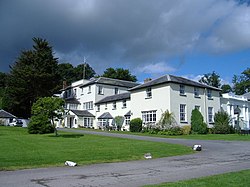 The Lord Haldon Country Hotel, Dunchideock developed from Haldon House | |
| Location | |
| Grid reference: | SX88228695 |
| Location: | 50°40’17"N, 3°34’59"W |
| History | |
| Built 1723 | |
| For: | Sir George Chudleigh |
| Country house | |
| Information | |
| Condition: | Largely demolished; converted to hotel |
Haldon House stands on the eastern side of the Haldon Hills in the parishes of Dunchideock and Kenn in Devon. It was once a fine, Georgian country house, but was largely demolished in the 1920s.
The surviving north wing of the house, comprising the entrance front of the stable block, consists of two cuboid lodges linked by a screen pierced by a Triumphal Arch, with later additions,[1] and serves today as the "Lord Haldon Hotel".[2] The house was originally flanked by two such paired pavilions, as is evident from 19th century engravings.
History
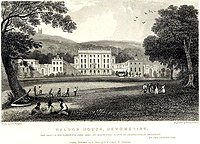
The house was built in about 1723[3] for Sir George Chudleigh, and was influenced by Buckingham House in London, built in about 1715.[1] Richard Polwhele in his History of Devonshire (1793) wrote:
About 70 years since Sir George Chudleigh began to build Haldon House. It is one of the best modern houses in Devonshire exectuted after the model of Buckingham House in St James's Park. Sir George Chudleigh died before the building was completed—[3]
Chudleigh's ancestral seat was at nearby Ashton House, on the west side of Haldon Hill, the residence of his family since about 1320, and which he abandoned to build Haldon House on the east side of the hill. In 1798 Ashton House lay in ruins.[4] He died without male progeny, leaving four daughters as co-heiresses; Haldon was inherited by his second daughter, Frances, and her husband Sir John Chichester. Chichester already had a grand seat in northern Devon, Youlston Park, and sold Haldon House to Mrs Anne Basset,[3] who (or whose trustees) sold it to John Jones.

In about 1770, Haldon was purchased from William Webber by Sir Robert Palk (1717–1798), a former officer of the East India Company and Governor of Madras Province, who enlarged it. Palk had intended to build a mansion at Torwood[5] in his manor of Tor Mohun, which he had purchased from Lord Donegal in about 1759, but where he had been unable to purchase various surrounding fields which interfered with the estate.[6] The Torwood estate was later developed by his successors into half of the resort of Torquay.
Major-General Stringer Lawrence (1697–1775), the first Commander-in-Chief of the British Army in India, spent his retirement at Haldon House as an honoured guest of his friend from Indian days Sir Robert Palk, to whom he bequeathed the huge sum of £50,000 and in whose memory in 1788 Palk erected the "Lawrence Tower" (alias "Haldon Belvedere") on his estate. In 1789 Haldon House was viewed by Rev. John Swete of nearby Oxton, Kenton|Oxton House, a connoisseur of the picturesque, and a former protegé of Palk's, who in his journal criticised its design in having two wings which swept forward in curves, which although effective in built-up London for Buckingham House, here resulted in much of the spectacular view of the surrounding countryside being blocked off from the front of the house.[7] Palk removed the formal gardens and replaced them with lawns and clumps of trees[7] in the then fashionable style. The house was visited by several notable people, including King George III (1760–1820), whom Sir Robert Palk escorted to view the Lawrence Tower along a specially made carriage drive.
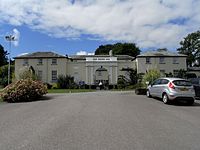
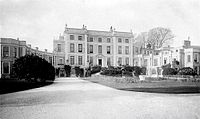
James FitzGerald Bannatyne (1 May 1833 - 18 October 1915) of Summerville and Fanningstown Castle in County Limerick, purchased Haldon House from the Palks in 1892. Mr Bannatyne was a Deputy Lieutenant and Justice of the Peace for Devon, and was a substantial flour merchant with premises in Dock Road in Limerick.[8] He was one of the nine original subscribers at the foundation in 1897 of the "Wireless Telegraph & Signal Company Ltd.", later "Marconi's Wireless Telegraph Co. Ltd.".[9] Marconi performed some of his early experiments in radio transmission from nearby Haldon Hills.
Mrs Ballantyne acquired the Palk Manuscripts, an important four-volume collection of the correspondence of Sir Robert Palk relating to Indian affairs.[10][11]
Bannatyne died in 1915, followed a few months later by his only son and heir, who was killed in action in France on 14 May 1916.[12] The widowed Mrs Bannatyne moved away in 1919 and sold the estate in lots, unable to find a single buyer..
In 1925 the house had six reception rooms (sizes 30 by 20 feet, 22 by 30, 50 by 17½, 28½ by 18½, 22 by 22½ and one other), 38 bedrooms, a ballroom, theatre and chapel to seat 100. No buyer could be found and with the gardens and a 5-acre field it was withdrawn at £1,350. The final sale of the last of the estate was in 1925. The furnishings of the chapel were purchased by Clifton College for its own chapel.[13] The house was largely demolished.
Haldon Belvedere
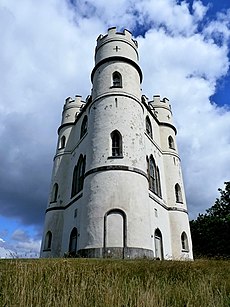
Within the former Haldon estate on Pen Hill about a mile south-west of the house is situated Haldon Belvedere, in the parish of Dunchideock,[14] built in 1788[14] by Sir Robert Palk, 1st Baronet. It was originally called the "Tower on Pen Hill"[15] or "Lawrence Tower" in honour of his friend and patron General Stringer Lawrence (1697–1775), who spent much of his retirement at Haldon and was buried in Dunchideock Church,[16] in which Sir Robert erected a monument to his memory, having received a bequest of £50,000 in his will.[14] Stringer Lawrence's other monument is in Westminster Abbey, erected by the East India Company.[14]
The tower, 85 feet high, is triangular with Gothic windows and full-height circular angle turrets, and was probably influenced by the triangular tower at nearby Powderham Castle, itself probably modelled on Shrubs Hill Tower (now Fort Belvedere) in Windsor Great Park, built 1750-1755 by Prince William Augustus, Duke of Cumberland (1721–1765), younger son of King George II.[14] Inside is a life-size coade stone statue of Stringer Lawrence dressed as a Roman general, a copy of the marble statue of him by Peter Scheemakers (1691–1781) now in the Foreign and Commonwealth Office, formerly the India Office. On the walls are three large framed tablets inscribed with details of his career.[14][17]
Following the Bannatyne sale, the Belvedere was purchased in about 1925 by a syndicate for £300 and in 1933 was acquired by the Dale family. During the Second World War it served as an observation post. After the War the building deteriorated and was struck by lightning in 1960. In 1990 the windows were blown out in a storm. Following the death of Cyril Dale in 1990, his successor Edward Dale[18] transferred in 1994 to the Stringer Lawrence Memorial Trust and in the same year it was restored by the [[Devon Historic Buildings Trust.[19] It has been a Grade II* listed building, under the name of "Lawrence Castle", since 1987.[20]
1789 description by Swete
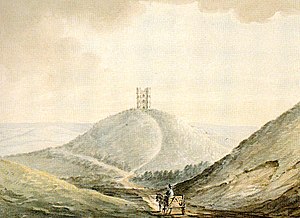
Rev. John Swete of nearby Oxton House, visited the tower in September 1789 and recorded in his Journal as follows:[21]
As we were now on our departure from Haldown on the descent of its northern extremity, we had before us a triangular tower raised by Sir Robert Palk and devoted to the memory of his friend General Lawrence. It had a round tower at each angle and rose three stories high. From its own elevation and that of the conical hill on which it was placed it became an object to the most distant parts of the county; it is hardly possible to conceive a spot better adapted to an edifice of this nature than this of Pen Hill, denominated so by the Britons on account of its eminence. I took the opposite sketch from the road from whence the pine-clad hill and the tower were seen in great perfection
The previously "wild and bare"[22] Haldon Hills had recently been planted with trees by Sir Robert Palk, which today surround the tower and cover the hill. Swete entered the tower and made transcripts of the three memorial tablets to Stringer Lawrence, and also transcribed the epitaph to him by Hannah More on his monument in nearby Dunchideock Church.
Outsode links
| ("Wikimedia Commons" has material about Haldon House) |
References
- ↑ 1.0 1.1 Nikolaus Pevsner: The Buildings of England: Devon, 1952; 1989 Penguin Books ISBN 978-0-300-09596-8page 513
- ↑ Barber, Chips & Barber, Sally, Around & About the Haldon Hills - Revisited, Obelisk Publications, 1996, pp.34–36
- ↑ 3.0 3.1 3.2 Polwhele: 'History of Devonshire', Vol. II (1793), p.181
- ↑ Gray & Rowe, Vol.1, p.11; Watercolour by Swete, Vol.2, p.33
- ↑ Torwood Manor painting by John Wallace Tucker (1863)
- ↑ Swete, Vol.1, p.165
- ↑ 7.0 7.1 Gray & Rowe, Vol.1, p.8
- ↑ Moloney, Tadhy, Limerick Constitutional Nationalism 1898-1918, Newcastle-Upon_Tyne, 2010, p.9 [1]
- ↑ Guglielmo Marconi and the “invention” of wireless
- ↑ Historical Manuscripts Commission: Report on the Palk manuscripts in the possession of Mrs Bannatyne of Haldon, Devon. (Historical Manuscripts Commission; no. 74,1922)[2]
- ↑ Winckworth, Archibald N. (1917–1997), (owner of Dunchideock House) 'Memories of Dunchideock' (GENUKI)
- ↑ Obituary [3]; War memorial in Doddiscombsleigh Church [4]
- ↑ Winckworth
- ↑ 14.0 14.1 14.2 14.3 14.4 14.5 Nikolaus Pevsner: The Buildings of England: Devon, 1952; 1989 Penguin Books ISBN 978-0-300-09596-8page 342
- ↑ Swete, 1789 Journal
- ↑ Fraser, Iain, Haldon's Hidden Heritage
- ↑ For 1789 transcripts of tablets see: Gray & Rowe, Vol.1, pp. 9–10
- ↑ Pidsley
- ↑ http://www.haldonbelvedere.co.uk/about-hb/
- ↑ National Heritage List 1097067: Lawrence Castle
- ↑ Gray & Rowe, Vol.1, pp. 8–9
- ↑ Gray & Rowe, Vol.1, p.11
- Risdon, Tristram: 'Survey of Devon' (before 1640)
- Nikolaus Pevsner: The Buildings of England: Devon, 1952; 1989 Penguin Books ISBN 978-0-300-09596-8.
- Fraser, Iain, The Palk Family of Haldon House & Torquay
- Gray, Todd and Rowe, Margery (Eds.), Travels in Georgian Devon: The Illustrated Journals of The Reverend John Swete, 1789–1800, 4 vols., Tiverton: Devon Books, 1999.
- Gray, Todd, The Garden History of Devon: An Illustrated Guide to Sources, Exeter, 1995, pp. 116–8, "Haldon House, Kenn"
- Pidsley, Rev. Christopher: 'The Tower on the Hill'
- Lauder, Rosemary: 'Vanished Houses of South Devon'
